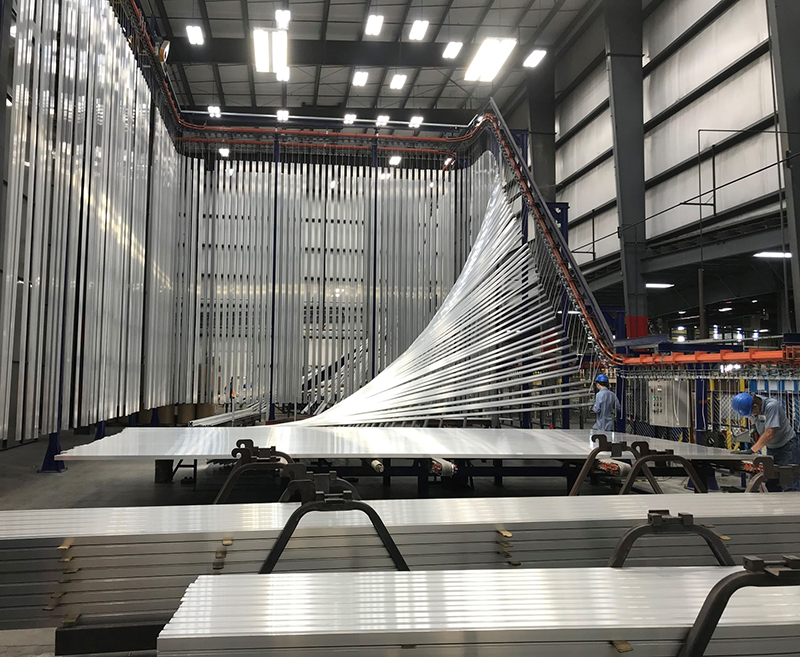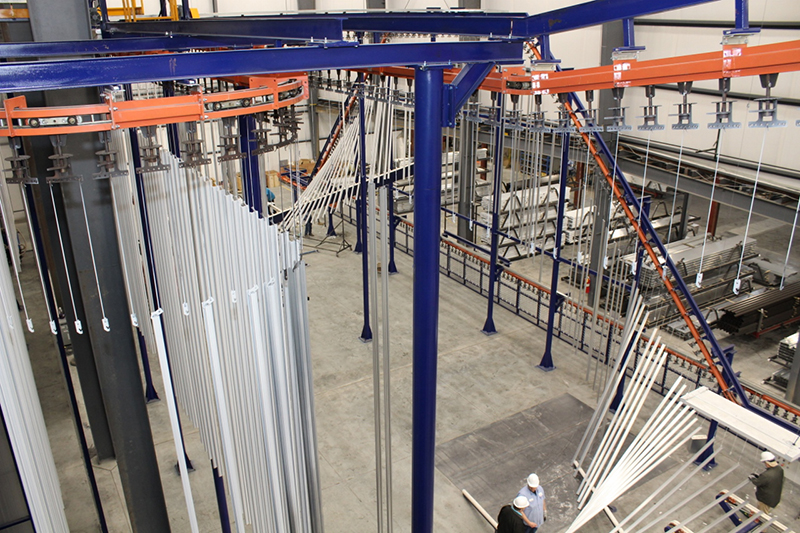The value of powder coating architectural aluminum façade building products - by Steve Chen

The advantages of powder coating are numerous for aluminum building products. Powder coating offers excellent finish, strong performance, and customization, while providing a more environmentally sustainable and cost-effective solution for long-term durability. These advantages are crucial to the architectural industry since environmental concerns and building construction and maintenance costs are ever-increasing. All building aluminum architectural elements such as window or door frames, storefront systems, curtain wall structures, façade panels, railings, fencing, column covers, light fixtures, and other decorative components are enhanced with powder coating finish.
Powder coating has been popular for the architectural sector in Europe since the 1970s when environmental issues began moving to the forefront in the design and construction industries. Increasingly over the past two decades, design and construction professionals in the U.S. and other parts of the world have begun to embrace powder coating for the built environment. This is primarily due to coating technology improvements making powder coating of aluminum superior to wet paint finishing in most applications, as well as the drive for greater sustainability and cost containment in manufacturing processes.

Market growth for architectural products
With enhanced awareness within the design and construction community of its benefits, powder coating for aluminum architectural products has enjoyed substantial growth in recent years. As cities and states across the country enact more aggressive environmental codes and architects specify products with greater sustainability in building design, building product manufacturers are evaluating cradle-to-grave implications of their products. For aluminum product finishing processes, powder coating offers substantial environmental benefits over liquid paint finishes, including:
• Low Volatile Organic Compounds (VOCs) and no toxic compounds in powder coatings.
• Single coat factory application and no job site application required.
• Powder over-spray reclamation and reuse.
• Non-chrome pretreatment of aluminum.
• Superior scratch, weather and corrosion resistance for long-term durability.
• Superior color and gloss retention.
• Lower temperature curing with lower energy costs.
• No hazardous production waste.
• EPA recommended.
• LEED point contribution.

Vertical integration
In 2003, my firm Crystal Window & Door Systems purchased an existing aluminum fabrication facility in Union, MO, with the goals of vertically integrating operations and controlling quality and cost for its growing aluminum window product lines.
Today, Crystal’s subsidiary Gateway Extrusions offers extrusion, fabrication, and finishing services for a wide range of aluminum products.
Building product manufacturers such as Crystal Windows that have experience with powder coating operations, especially with their own powder coating facilities, can provide valuable insights and recommendations to architects, specifiers, developers, and contractors on the types of finishes available.
From paint to powder
Initially, Gateway’s aluminum extrusions were finished with liquid paint, as was typical of the industry. However, soon after starting operations, the company opted to replace the paint line with a new more modern powder coat system. Gateway’s powder coat line enables the company to accommodate demand for more consistent finish quality, longer profiles, and faster turnaround in the architectural market.
Powder coating equipment comes in horizontal and vertical configurations, each with benefits. Horizontal powder coat systems permit even coating of large flat components, such as shutters and panels, or smaller components such as fence caps and light fixtures regardless of orientation on the line. They are ideal for finishing companies handling smaller batch jobs, shorter lengths of aluminum extrusions, and frequent color changes. They are also well suited for production facilities with limited ceiling height, without the same level of capital investment required for vertical powder coat systems.
Vertical powder coating lines (which Gateway utilizes) offer faster production speeds, can handle longer components, and require less floor space for pre-treatment, powder application, and drying than horizontal lines.
They do require significantly greater ceiling heights however – Gateway had to build an addition with a 50-foot ceiling height to accommodate its new vertical line. Vertical lines are most cost effective for finishers with high volume, large batch jobs.
Supplier Partnerships
 Building strong relationships with powder suppliers and application equipment manufacturers is critical for powder coating finishers. Crystal Windows and Gateway use a network of leading national powder suppliers who provide state-of-the-art formulations and essential on-site technical support, keeping operations flowing smoothly and efficiently.
Building strong relationships with powder suppliers and application equipment manufacturers is critical for powder coating finishers. Crystal Windows and Gateway use a network of leading national powder suppliers who provide state-of-the-art formulations and essential on-site technical support, keeping operations flowing smoothly and efficiently.
Several challenges to the current supply chain in the powder coating industry demonstrate how important these relationships are. Raw material shortages and cost inflation over the past two years has raised costs for powder components such as resins, curing agents, and pigments and forced many powder suppliers to put customers on allocation. This has caused greater lead times for product finishers providing a wide range of aluminum building products and increased costs and surcharges. To mitigate this for example, suppliers for Crystal Windows and Gateway have purchased and maintained additional raw material supplies to keep their customers stocked and costs relatively stable and predictable.
Another advantage powder coating has over liquid paint arises from the competition across many other industries for resin raw materials. Products such as solar panels used to power smaller products, medical devices, electronic equipment, and Lithium-ion batteries for electric vehicles also use resin and this puts tremendous strain on resin component availability. This primarily impacts liquid paint supply, which can require five times the high-demand resin components as powder.
The future of powder coating for façade products
Façade product powder coating will continue to grow due to its superior performance and “green” characteristics. Architects are increasingly aware that powder coating can perform well in even the most severe climates – harsh sun, salt air and spray, and temperature extremes – and they will continue to specify powder coating to protect aluminum windows and other façade elements. Building product manufacturers will seek powder coating fabricators certified for AAMA durability performance standards 2603, 2604, and 2605 to meet this demand. They will also promote their powder coated products as the more sustainable choice, helping building construction and renovation projects earn LEED points and meet sustainability goals across the country, with independent lab testing to demonstrate the powder coating finish level of aluminum architectural products. The future for architectural product powder coating is bright.
Steve Chen is the president of Crystal Window & Door Systems, Queens, N.Y.
Mount Vernon Co. acquires John Carver Inn & Spa in Plymouth, MA


Recently passed legislation creates opportunities to meet CT’s changing energy needs - by Klein and Feinn

Selecting the right façade installation firm - by Steven Powell


.png)





.png)
